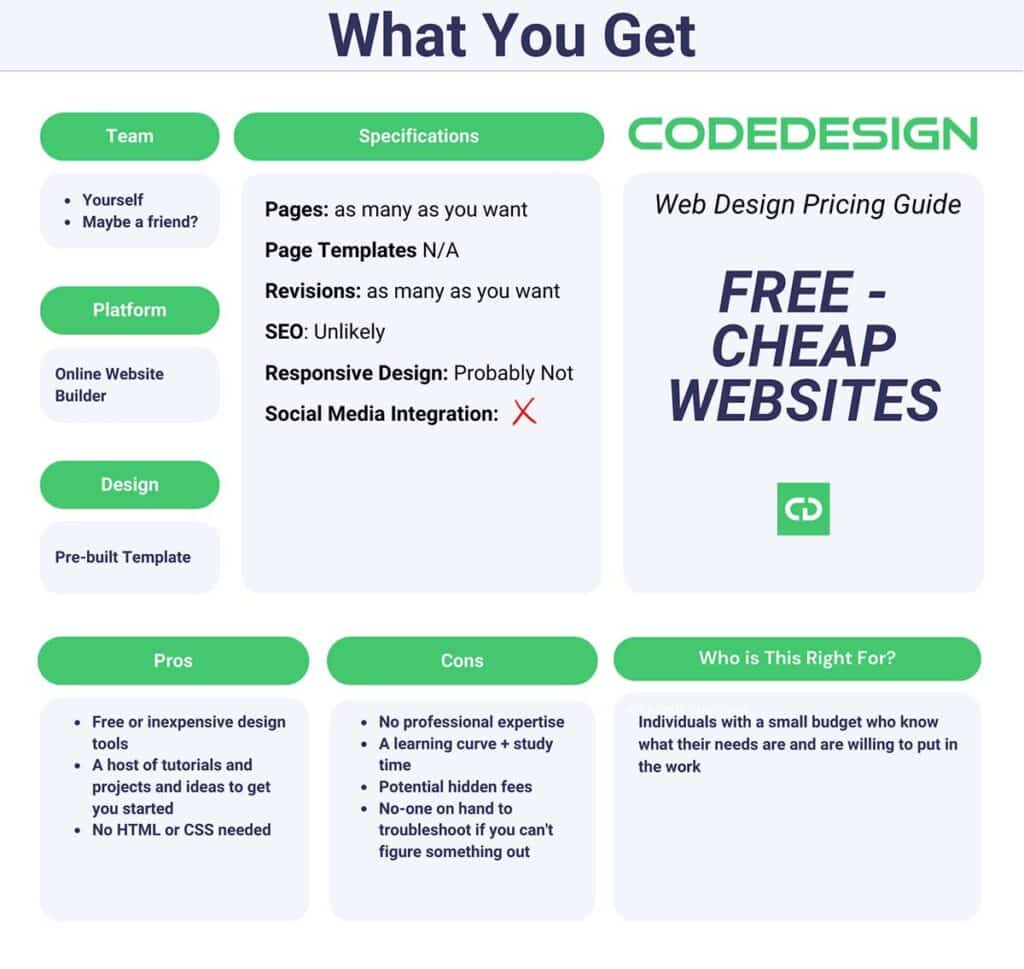Pricing out a new website or redesign can be tricky, especially when you start comparing design agencies as well as features. There can be lots of reasons for this -experience of the designers, the firm’s price per hour, number of team members, whether they’re creating something custom vs using a template, etc- but the question remains: how much should your website really cost?
Table of Contents
- Important Features in any Web Design
- How Can Poor Web Design Impact your Business?
- Qualities of a Professional Web Design Agency
- Local Web Design vs Big Business Corps
- Pricing Table
- Free & Cheap Website Designs
- $2.5K – $5K Website Designs
- $5K – $10K Website designs
- $10k – $25K Website Designs
- $25K+ Website Designs
- E-Commerce
- Unique Functionality
- Index of Terms
- Frequently Asked Questions
Important Features in any Website Design
With so much to think about when it comes to web design, where should you direct your focus? Here’s a short, non-exhaustive list of things we personally feel are signs of a thoughtfully designed website.
- Simple and user-focused front-end design makes sure a website works well from browser to browser, on different screens, and gives users a smooth experience.
- A user-friendly Content Management System (CMS) lets website owners easily update and handle their content on the back-end.
- Accessibility and data security measures ensure the website can be used by everyone and protect important information.
- Improving a website for search engines helps more people find it and brings in better natural traffic.
- Analytics and data tracking help understand user behavior and make smart decisions based on data.
- Adding third-party features, like social media links, improves the website’s functionality and expands its reach.
How Can Poor Web Design Impact your Business?

Poor web design can have a real impact on your business. A poor user interface design means visitors may leave your site if it looks unprofessional or difficult to navigate. Inconsistent coding practices and disorganized layouts can also cause conflicts and compatibility issues server-side, and poor design can just plain affect your brand image and credibility.
What Sets a Quality Design Agency Apart?

Everyone has a slightly different idea in their heads when they say the word “good”, and wildly different ideas when they say the word “great”. Even still, there are certain abilities, methods and qualities in an experienced designer and developer that sets them apart, and it’s not all visual design elements.
Quality of code
The functionality and performance of a website depends on the quality of its code. Talented designers have the ability to adapt to client requests while maintaining design coherency, and implement good practices like version control.
It’s important to note that inexperienced designers and developers may create code that doesn’t integrate well with existing code. Certifications are great, but a bachelor’s degree in computer science is only going to get you so far if you don’t have real world experience. Beyond a developer’s proficiency with the programming languages that go into a website (HTML and CSS, yes, but also javascript, python, php and more) is the question of how much time they would need to spend -on your dollar- adapting to anything you already have in place and integrating with the source code.
Clean and efficient code that maintains good standards, on the other hand, makes it easier not just to integrate in the beginning but to maintain and update the website in the future. Moreover, investing in well-written code can save you money in the long run as you won’t have to pay for a full redesign to make changes.
Custom vs Template Design
The difference between web designs from templates and custom designs lies in functionality and uniqueness. Templates offer time-saving simplicity and a lower cost but often come with limited functionalities that may not fully align with unique website requirements (or even basic usability). While it may seem endlessly tempting to use a template and then adapt it to your needs, practically speaking you’re likely to spend more trying to make it work than you would just hiring a more experienced designer. On top of that, you’re not settling for anything you’re not 100% happy with.
The adage “you get what you pay for” often rings true in the world of web design. Be cautious when selecting a designer claiming to offer custom designs, as many may secretly rely on templates, especially if their fees are lower than average.
Custom Media & Copywriting
The distinction between designers who utilize premade media and pre-written content versus those capable of creating bespoke solutions for each client lies in the cohesiveness and professionalism of the final product. While pre-made elements might appear visually appealing individually, they often lack congruency when combined, resulting in a subtly unprofessional appearance clients may not even be able to entirely put their finger on, but is none-the-less felt.
Skilled designers take advantage of media creation as an opportunity to integrate relevant keywords strategically, laying the foundation for a search engine optimized (SEO) website right from the start. This not only enhances the website’s visibility and rankings but also ensures that it aligns organically with the client’s brand and objectives.
Additionally, using licensed graphics can help you avoid potential legal issues and make a lasting professional impression. Invest wisely in custom media and copywriting for future success.
Keyword Research & SEO
Keyword research is the backbone of SEO as it helps identify relevant terms and phrases to optimize your website’s visibility. Where a mediocre designer begins their SEO work when the website is launched, a good designer can seamlessly integrate relevant keywords throughout the design, including in custom copywriting and media creation. By doing so, they enhance the website’s search engine visibility and organic ranking, ultimately driving more targeted traffic and potential customers. A less experienced designer may not even be aware of the importance of keyword research or the opportunity it presents for optimizing a website’s performance.
By combining great graphic design with strategic keyword integration, web designers can empower each webpage for SEO success. Analyzing keyword performance provides valuable insights for ongoing optimization, ensuring your website stays competitive in search engine rankings.
Reliability & Ability to Problem Solve
A reliable and skilled web designer/developer is one who excels in problem-solving and demonstrates proficiency in various relevant fields. For instance, a full-stack developer should have experience in both front-end and back-end technologies, enabling them to handle diverse challenges effectively. Meanwhile, a business with multiple professionals relies on rock solid communication and project management to keep the project cohesive and well-coordinated.
Timeliness is also a key indicator of a professional’s reliability, as a good designer/developer respects deadlines and is punctual for meetings, demonstrating commitment and respect for the client’s time.
A web developer’s job includes staying updated on essential aspects like privacy laws, interface design, and accessibility requirements to ensure compliance with industry standards and regulations. They should be well-versed in current technologies, including browser compatibility, mobile device optimization, and considerations for different bandwidths and connectivity levels to ensure a responsive and user-friendly website.
An experienced web designer has the ability to problem solve effectively, and manage their work and time without undue time or input from the client. With their expertise, they can swiftly resolve a myriad of issues that may arise during the development phase- addressing conflicts between client-requested changes and existing features, fixing CMS malfunctions, integrating 3rd party plugins, and resolving database corruption, to name a few. By tackling these challenges in real time, skilled web designers can avoid project delays and ensure a smooth workflow. In contrast, inexperienced designers may waste time and create problems later on.
As a non-professional in the web development field, it can be challenging to tell if the information provided is accurate. A skilled developer or team should be able to explain complex issues clearly and concisely, and be able to adjust their level of technicality to the client’s level of understanding. You should always be making informed decisions, every step of the way.
Local Web Design vs Big Business Corps
While big businesses may churn out sleek and functional websites at scale, they come with some major drawbacks: They’re likely extremely generic, have relatively limited functionality, and the minimum cost for a basic website is likely higher than what a local firm would charge for something much more advanced and customized.
Local firms offer a personalized experience and invest more time in understanding your unique needs and aspirations. Local firms stake their reputation on the quality of every website they create or redesign, all at much more competitive rates.
Personal investment
Smaller local web design agencies put their reputation on the line with every website they create or improve. Because they’re focused on fewer clients, and specifically clients who live and work in their community, they understand the client’s needs, know how their business fits into the local community, and genuinely care about that client as a person.
Personal investment goes beyond just the financial aspect and encompasses time, effort, and trust in the web designer. Working closely with a web designer allows you to provide input throughout the process, ensuring the final product aligns with your expectations.
Moreover, the personal investment extends to the long-term success of your website, as updates and maintenance will always be required.
Who is actually creating your website?
When hiring a web designer, it’s important to consider who is actually creating your website.
While big budget corporate firms may deliver quality work, they often outsource to less experienced designers to cut costs-and then pocket the difference. And how would you possibly know? After all, the only person you interact with is the project manager.
Instead, choose a local web development firm that is transparent about their team’s expertise and values you as a person. Outsourcing to low-wage developers can impact the quality and effectiveness of your website.
Pricing Table
| TEAM | FREE | $1,000 | $2,500 | $5K – $10K | $10K – $25K | $25K+ |
|---|---|---|---|---|---|---|
| Firm | 🗙 | 🗙 | 🗙 | ✔ | ✔ | ✔ |
| Developer | 🗙 | 🗙 | 🗙 | ✔ | ✔ | ✔ |
| Project Manager | 🗙 | 🗙 | 🗙 | ✔ | ✔ | ✔ |
| Content Writer | 🗙 | 🗙 | 🗙 | 🗙 | 🗙 | ✔ |
| UI/ UX Designer | 🗙 | 🗙 | 🗙 | ✔ | ✔ | ✔ |
Free & Cheap Website Designs
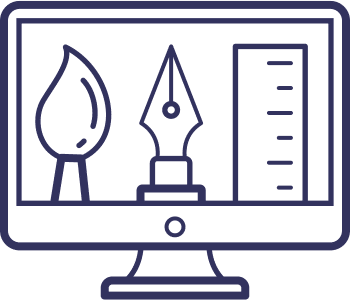
If you want a new or improved website for free, you’re in luck! There are plenty of DIY solutions you can use to build it yourself. Many of these options will be ad-heavy unless you upgrade, and may potentially come with hidden fees. The nice thing about free website builders is that you don’t have to learn html and css in order to start creating.
If you feel confident in your design and development skills, there’s no reason not to give it a try. And if later down the road you find yourself looking for some updates to your site design that are beyond your skill level, many professional website designers are happy to do website redesigns.
$2.5K – $5K Website Designs
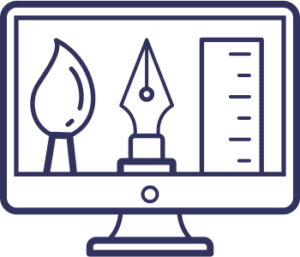
$2,500 is probably the minimum bar for a simple, high quality and budget oriented design. You probably won’t find a ton of built in features, but with the right firm you can get the job done. Note that many designers who claim to produce custom content below this price are likely using a template and keeping quiet about it to make the business model and price point possible.
As we approach the 5K end of the spectrum, more complexity gets added in.

$5K – $10K Website Designs
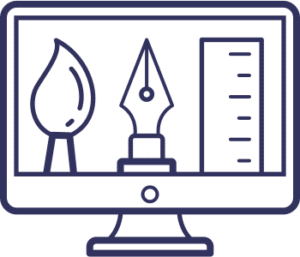
You’ll almost certainly get dedicated QA testing, a site map, on-page SEO, and more. At this price, you can expect a professional team with the design, development and SEO chops to create something truly custom. If you find the right firm, you may be able to score a project manager, API integrations, membership or gated content sections, third party integrations, be optimized for search engines like google and bing, and more
Your dedicated project manager will be able to make your life astronomically easier by handling the organization and management portions of the design process. If you’re lucky with your choice of designer, you may even be able to get logo and branding services at the higher end of this range.
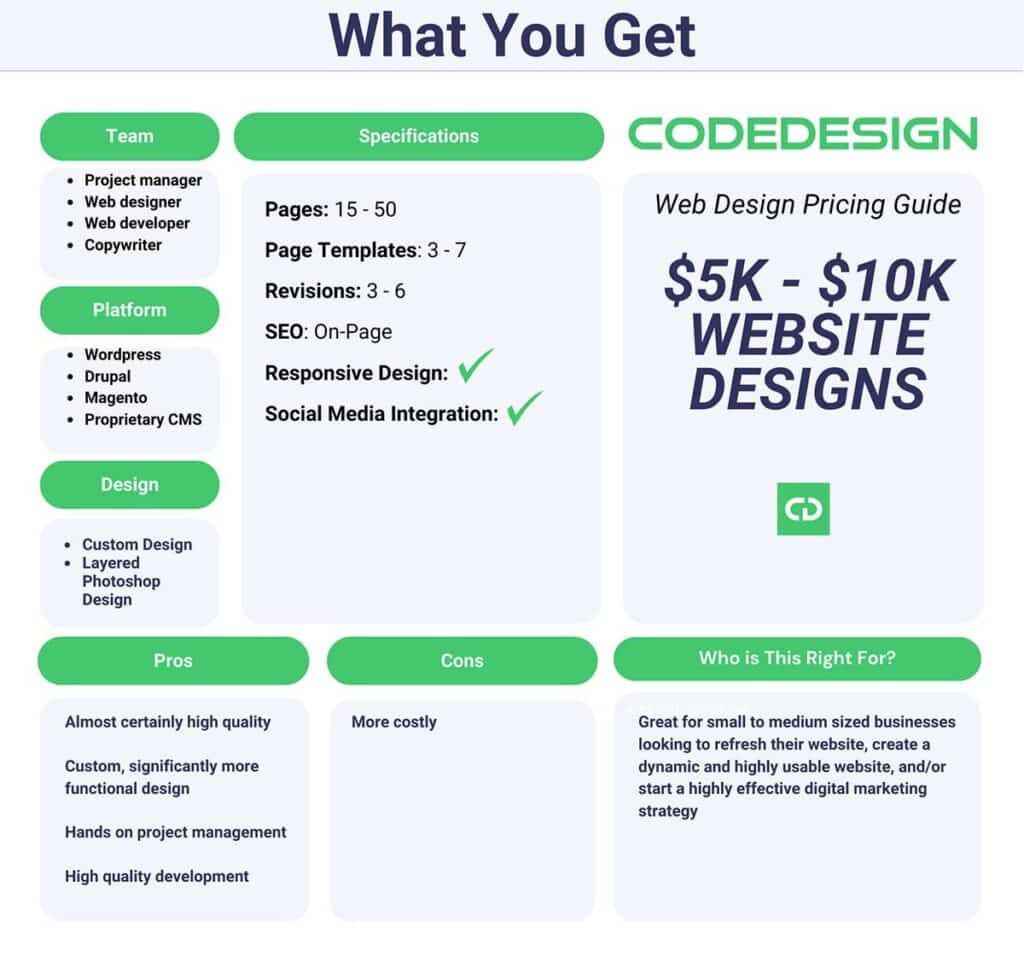
$10k – $25K Website Designs
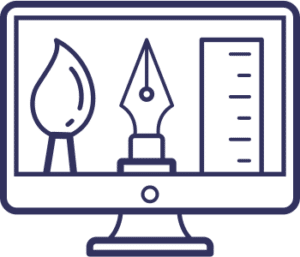
This price range is where you see the widest variation in skill level. If you find yourself with a small business design firm that has outsized skills, you’ll likely score unique back end and front end development, custom functionality, hundreds of unique pages, and more. It’s equally possible, though, to end up with a huge corporation charging you the same price for a small, 4-6 page site.
One of the reasons for this is that you’re paying for the reputation of the designer, and the guarantee that the project will be brought to successful completion. Simplicity isn’t necessarily a bad thing, of course, and that tiny site will almost certainly be elegant in that simplicity. If you’re looking for more value per dollar, though, a smaller firm with great reviews is more the way to go.

$25K+ Website Designs

When paying over $25,000 for web design, you can reasonably expect a top-tier level of design, development, and custom features tailored to your specific needs and goals.
The design will be professionally crafted with a strong emphasis on visual appeal, brand identity, and user experience. It will likely be fully custom, reflecting your brand’s unique personality and values. The development process will involve high-level programming and optimization to ensure the website is fast, secure, and scalable.
Expect advanced custom features, such as interactive elements, animations, and personalized user experiences. Integration with third-party APIs and services will be seamless, expanding the website’s capabilities. E-commerce functionality, if required, will be robust and comprehensive, offering a secure and efficient online shopping experience.

E-Commerce
Adding ecommerce functionality to a website significantly increases the complexity and cost of development due to several reasons:
Product Catalog: Creating a system to manage and display products with multiple variations, images, and descriptions.
Shopping Cart & Checkout: Implementing a secure and user-friendly shopping cart system that allows users to add, modify, and remove items, as well as a secure checkout process with payment gateway integration.
Inventory Management: Developing a mechanism to track product availability and update stock levels in real-time.
User Accounts: Building user registration, login, and account management features for customers.
Order Management: Creating a system for order processing, tracking, and handling returns/refunds.
Security & Compliance: Ensuring the website is secure to protect sensitive customer data and complying with industry standards and regulations.
Performance Optimization: Optimizing the website for fast loading times and smooth user experience, even with a large number of products.
Mobile Responsiveness: Ensuring the ecommerce website functions flawlessly on various devices.
The cost of adding ecommerce functionality varies depending on the scale and complexity of the project. Generally, adding ecommerce to a website could add anywhere from $5,000 to $15,000 or more to the overall price, depending on the number of products, desired features, and level of customization required.
It’s important to work with experienced developers who understand ecommerce development to ensure a successful and secure online store that meets your business needs.
Unique Functionality
When we say ‘Unique functionality’, we’re really saying ‘custom things not standardly included in a website’. This is a hugely broad category, and can include anything from personalized dashboards or user profiles to custom shipping solutions for for an online store.
Interactive Product Customization: Allowing customers to personalize products with custom colors, designs, engravings, or other unique features directly on the website.
Dynamic Content Filtering: Adding advanced filtering options that allow users to refine content or search results based on specific criteria, making it easier to find relevant information.
Personalized Dashboards or User Profiles: Offering users personalized dashboards or profiles that display relevant information and allow customization.
Collaborative Shopping: Allowing multiple users to shop together in real-time, adding items to a shared cart, and discussing potential purchases through chat or video conferencing.
Product Bundling and Recommendation Engine: Implementing a sophisticated recommendation system that suggests product bundles based on customer preferences and browsing history.
Gamification Elements: Incorporating game-like features, challenges, or rewards to engage users and encourage interaction with the website. This could be relevant for loyalty programs or interactive content.
User-Generated Content and Community Features: Allowing users to submit and share their content, such as articles, stories, or artwork, to foster a sense of community and engagement.
And so much more. The cost of implementing unique functionality can significantly impact the overall price of a website. Depending on the complexity and technical requirements, adding unique functionality could add anywhere from $5,000 to $50,000 or more to the development cost. The price will depend on the level of customization needed, the expertise required for development, and the integration with external services or APIs.
Index of Terms
HTML: Hypertext markup language
CSS: Cascading style sheets
UX: User experience design
Front end developers: the people responsible for how the parts of your website that the user sees looks and functions
Back-end developers: the people responsible for making your website function in the ways that you need it to
Full-stack developers: Those who can work on the front end and back end of your website equally. Hiring a full-stack web developer or team saves time and money over hiring two separate parties to handle their respective portions individually.
Frequently Asked Questions
What are the benefits of using a web design company?
Web design companies offer numerous benefits. They have a team of professionals skilled in various aspects of web design, ensuring a visually appealing and user-friendly website. With custom designs tailored to your business needs, ongoing support, and maintenance, hiring a web design company is a wise choice.
What types of web design services should I be looking for?
When searching for web design services, prioritize finding a web designer who offers custom solutions tailored to your needs. Look for expertise in responsive design, ongoing maintenance and support services, and experience with SEO optimization.
How do I choose the best web designer for my project?
Determine your budget and project scope before searching. Find designers with experience in your industry. Review portfolios to align with your vision. Seek recommendations or read reviews from previous clients.
How much should I pay a website designer?
The cost of hiring a website designer can vary based on factors such as their experience, expertise, and the complexity of your project. Basic website designs typically range from $500 to $5,000, while more complex websites with additional features can cost $5,000 to $20,000 or more. Discussing your budget and requirements with multiple designers will help you find the right fit within your price range.
How can I get my website designed for free?
You can get your website designed for free by utilizing platforms like Wix, Weebly, and WordPress.com. These platforms offer free website builders with customizable templates. Additionally, some web hosting providers include website building tools in their packages. Keep in mind that free options may have limitations on design and functionality.


